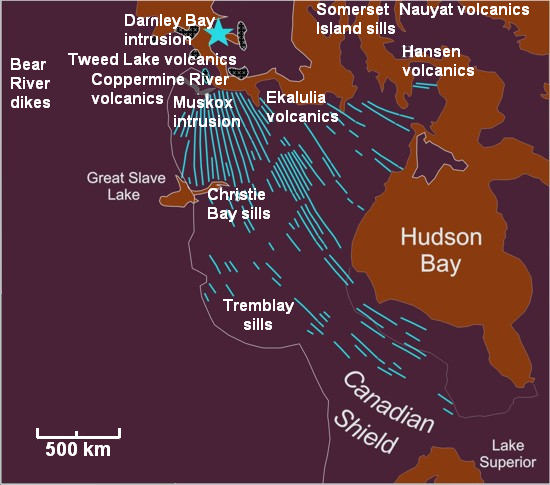Coppermine River Group on:
[Wikipedia]
[Google]
[Amazon]
 The Coppermine River Group is a sequence of
The Coppermine River Group is a sequence of
 The Coppermine River Group is a sequence of
The Coppermine River Group is a sequence of Mesoproterozoic
The Mesoproterozoic Era is a geologic era that occurred from . The Mesoproterozoic was the first era of Earth's history for which a fairly definitive geological record survives. Continents existed during the preceding era (the Paleoproterozoic ...
continent
A continent is any of several large landmasses. Generally identified by convention rather than any strict criteria, up to seven geographical regions are commonly regarded as continents. Ordered from largest in area to smallest, these seven ...
al flood basalt
A flood basalt (or plateau basalt) is the result of a giant volcanic eruption or series of eruptions that covers large stretches of land or the ocean floor with basalt lava. Many flood basalts have been attributed to the onset of a hotspot reac ...
s forming part of the Mackenzie Large Igneous Province
The Mackenzie Large Igneous Province (MLIP) is a major Mesoproterozoic large igneous province of the southwestern, western and northwestern Canadian Shield in Canada. It consists of a group of related igneous rocks that were formed during a massive ...
in the Northwest Territories
The Northwest Territories (abbreviated ''NT'' or ''NWT''; french: Territoires du Nord-Ouest, formerly ''North-Western Territory'' and ''North-West Territories'' and namely shortened as ''Northwest Territory'') is a federal territory of Canada. ...
and Nunavut
Nunavut ( , ; iu, ᓄᓇᕗᑦ , ; ) is the largest and northernmost territory of Canada. It was separated officially from the Northwest Territories on April 1, 1999, via the '' Nunavut Act'' and the '' Nunavut Land Claims Agreement Act'' ...
, Canada
Canada is a country in North America. Its ten provinces and three territories extend from the Atlantic Ocean to the Pacific Ocean and northward into the Arctic Ocean, covering over , making it the world's second-largest country by tota ...
. It is among the largest flood basalt provinces on Earth, covering the area with a volume of approximately .
Eruptive history
The Coppermine River Group was formed when vast volumes ofbasalt
Basalt (; ) is an aphanitic (fine-grained) extrusive igneous rock formed from the rapid cooling of low-viscosity lava rich in magnesium and iron (mafic lava) exposed at or very near the surface of a rocky planet or moon. More than 90% of a ...
ic lava
Lava is molten or partially molten rock ( magma) that has been expelled from the interior of a terrestrial planet (such as Earth) or a moon onto its surface. Lava may be erupted at a volcano or through a fracture in the crust, on land or ...
paved over a large area of the northwestern Canadian Shield about 1,267 million years ago. These basalts form flood basalt
A flood basalt (or plateau basalt) is the result of a giant volcanic eruption or series of eruptions that covers large stretches of land or the ocean floor with basalt lava. Many flood basalts have been attributed to the onset of a hotspot reac ...
s that reach thicknesses ranging from to and consists of about 150 lava flows, each about 10–25 m thick. Except for the lowermost flows, which contain evidence of interaction with water, the entire sequence was erupted subaerially. Eruption of plateau
In geology and physical geography, a plateau (; ; ), also called a high plain or a tableland, is an area of a highland consisting of flat terrain that is raised sharply above the surrounding area on at least one side. Often one or more sides ...
lavas near the Coppermine River
The Coppermine River is a river in the North Slave and Kitikmeot regions of the Northwest Territories and Nunavut in Canada. It is long. It rises in Lac de Gras, a small lake near Great Slave Lake, and flows generally north to Coronation Gulf ...
, built an extensive volcanic plateau
A volcanic plateau is a plateau produced by volcanic activity. There are two main types: lava plateaus and pyroclastic plateaus.
Lava plateau
Lava plateaus are formed by highly fluid basaltic lava during numerous successive eruptions th ...
about 1,200 million years ago with an area of about representing a volume of lavas of at least . These flood basalts have been interpreted as contemporaneous with the giant Mackenzie dike swarm
The Mackenzie dike swarm, also called the Mackenzie dikes, forms a large igneous province in the western Canadian Shield of Canada. It is part of the larger Mackenzie Large Igneous Province and is one of more than three dozen dike swarms in vario ...
and with the Muskox intrusion
The Muskox intrusion is a layered intrusion in Nunavut, Canada. It is located northeast of Great Bear Lake and south of Kugluktuk on Coronation Gulf. It was formed during a large magmatic event during the Proterozoic by hotspot or mantle plume v ...
.Gunter Faure, ''Origin of Igneous Rocks'', Springer, 1st ed., 2000, pp. 357 - 358,
See also
* Natkusiak flood basalts * Volcanology of Canada *Volcanology of Northern Canada
Volcanism of Northern Canada has produced hundreds of volcanic areas and extensive lava formations across Northern Canada. The region's different volcano and lava types originate from different tectonic settings and types of volcanic eruptions, ra ...
References
{{coord missing, Northwest Territories Volcanism of the Northwest Territories Mesoproterozoic volcanism Hotspot volcanism Mackenzie Large Igneous Province